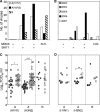MDCK-SIAT1 cells show improved isolation rates for recent human influenza viruses compared to conventional MDCK cells
- PMID: 18480230
- PMCID: PMC2446904
- DOI: 10.1128/JCM.00398-08
MDCK-SIAT1 cells show improved isolation rates for recent human influenza viruses compared to conventional MDCK cells
Abstract
The ability to isolate and propagate influenza virus is an essential tool for the yearly surveillance of circulating virus strains and to ensure accurate clinical diagnosis for appropriate treatment. The suitability of MDCK-SIAT1 cells, engineered to express increased levels of alpha-2,6-linked sialic acid receptors, as an alternative to conventional MDCK cells for isolation of circulating influenza virus was assessed. A greater number of influenza A (H1N1 and H3N2) and B viruses from stored human clinical specimens collected between 2005 and 2007 were isolated following inoculation in MDCK-SIAT1 cells than in MDCK cells. In addition, a higher titer of virus was recovered following culture in MDCK-SIAT1 cells. All A(H1N1) viruses recovered from MDCK-SIAT1 cells were able to agglutinate both turkey and guinea pig red blood cells (RBC), while half of the A(H3N2) viruses recovered after passage in MDCK-SIAT1 cells lost the ability to agglutinate turkey RBC. Importantly, the HA-1 domain of the hemagglutinin gene was genetically stable after passaging in MDCK-SIAT1 cells, a feature not always seen following MDCK cell or embryonated chicken egg passage of human influenza virus. These data indicate that the MDCK-SIAT1 cell line is superior to conventional MDCK cells for isolation of human influenza virus from clinical specimens and may be used routinely for the isolation and propagation of current human influenza viruses for surveillance, diagnostic, and research purposes.
Figures


Similar articles
-
The characteristics and antigenic properties of recently emerged subclade 3C.3a and 3C.2a human influenza A(H3N2) viruses passaged in MDCK cells.Influenza Other Respir Viruses. 2017 May;11(3):263-274. doi: 10.1111/irv.12447. Epub 2017 Feb 28. Influenza Other Respir Viruses. 2017. PMID: 28164446 Free PMC article.
-
High genetic stability in MDCK-SIAT1 passaged human influenza viruses.J Infect Chemother. 2019 Mar;25(3):222-224. doi: 10.1016/j.jiac.2018.08.012. Epub 2018 Sep 18. J Infect Chemother. 2019. PMID: 30241880
-
Structural and evolutionary characteristics of HA, NA, NS and M genes of clinical influenza A/H3N2 viruses passaged in human and canine cells.J Clin Virol. 2009 Aug;45(4):322-33. doi: 10.1016/j.jcv.2009.05.030. J Clin Virol. 2009. PMID: 19546028
-
Comparison of the usefulness of the CACO-2 cell line with standard substrates for isolation of swine influenza A viruses.J Virol Methods. 2010 Jan;163(1):162-5. doi: 10.1016/j.jviromet.2009.09.017. Epub 2009 Sep 23. J Virol Methods. 2010. PMID: 19781571
-
Isolation of the pandemic (H1N1) 2009 virus and its reassortant with an H3N2 swine influenza virus from healthy weaning pigs in Thailand in 2011.Virus Res. 2012 Oct;169(1):175-81. doi: 10.1016/j.virusres.2012.07.025. Epub 2012 Aug 10. Virus Res. 2012. PMID: 22906589
Cited by
-
Influenza virus A(H1N1)pdm09 hemagglutinin polymorphism and associated disease in southern Germany during the 2010/11 influenza season.Arch Virol. 2013 Jun;158(6):1297-303. doi: 10.1007/s00705-013-1610-1. Epub 2013 Feb 9. Arch Virol. 2013. PMID: 23397331 Free PMC article.
-
Sustained delivery of CpG oligodeoxynucleotide by acetalated dextran microparticles augments effector response to Computationally Optimized Broadly Reactive Antigen (COBRA) influenza hemagglutinin.Int J Pharm. 2023 Jan 5;630:122429. doi: 10.1016/j.ijpharm.2022.122429. Epub 2022 Nov 25. Int J Pharm. 2023. PMID: 36436743 Free PMC article.
-
Sequence amplification via cell passaging creates spurious signals of positive adaptation in influenza virus H3N2 hemagglutinin.Virus Evol. 2016 Jul;2(2):vew026. doi: 10.1093/ve/vew026. Epub 2016 Oct 3. Virus Evol. 2016. PMID: 27713835 Free PMC article.
-
Antigenic Pressure on H3N2 Influenza Virus Drift Strains Imposes Constraints on Binding to Sialylated Receptors but Not Phosphorylated Glycans.J Virol. 2019 Oct 29;93(22):e01178-19. doi: 10.1128/JVI.01178-19. Print 2019 Nov 15. J Virol. 2019. PMID: 31484755 Free PMC article.
-
Comparison of egg and high yielding MDCK cell-derived live attenuated influenza virus for commercial production of trivalent influenza vaccine: in vitro cell susceptibility and influenza virus replication kinetics in permissive and semi-permissive cells.Vaccine. 2010 May 14;28(22):3848-55. doi: 10.1016/j.vaccine.2010.03.005. Epub 2010 Mar 20. Vaccine. 2010. PMID: 20307595 Free PMC article.
References
-
- Baum, L. G., and J. C. Paulson. 1990. Sialyloligosaccharides of the respiratory epithelium in the selection of human influenza virus receptor specificity. Acta Histochem. Suppl. 4035-38. - PubMed
-
- Belsey, M. J., B. de Lima, A. K. Apvlou, and J. W. Savopoulos. 2006. Influenza vaccines. Nat. Rev. Drug Discov. 5183-184. - PubMed
-
- Burnet, F. 1940. Influenza virus infections of the chick embryo by the amniotic route. Aust. J. Exp. Biol. Med. Sci. 18353-360.
-
- Burnet, F. 1941. Growth of influenza virus in the allantoic cavity of the chick embryo. Aust. J. Exp. Med. Sci. 19291-295.
-
- Centers for Disease Control. 1982. Concepts and procedures for laboratory-based influenza surveillance. Centers for Disease Control, Atlanta, GA.
Publication types
MeSH terms
Substances
LinkOut - more resources
Full Text Sources
Other Literature Sources
Medical
Research Materials

